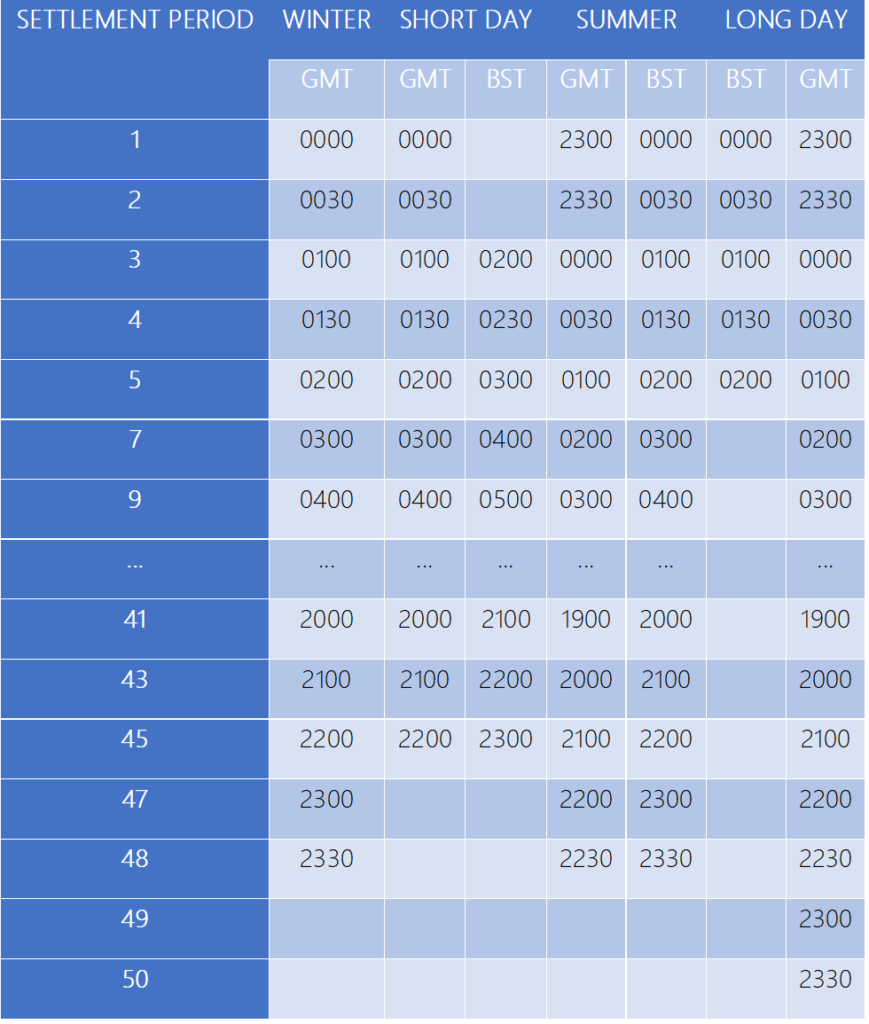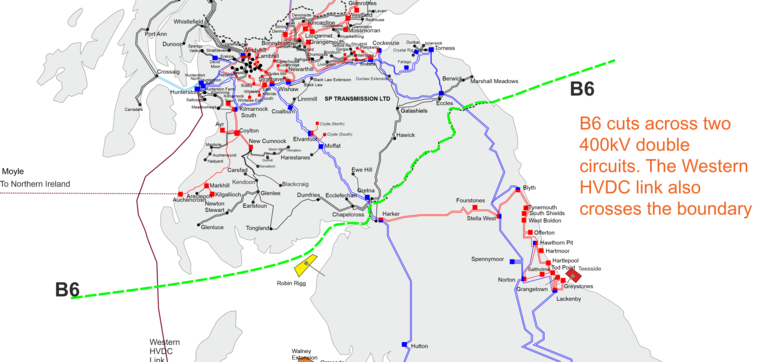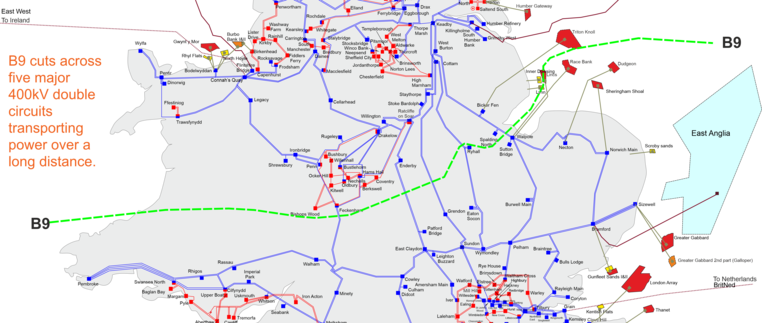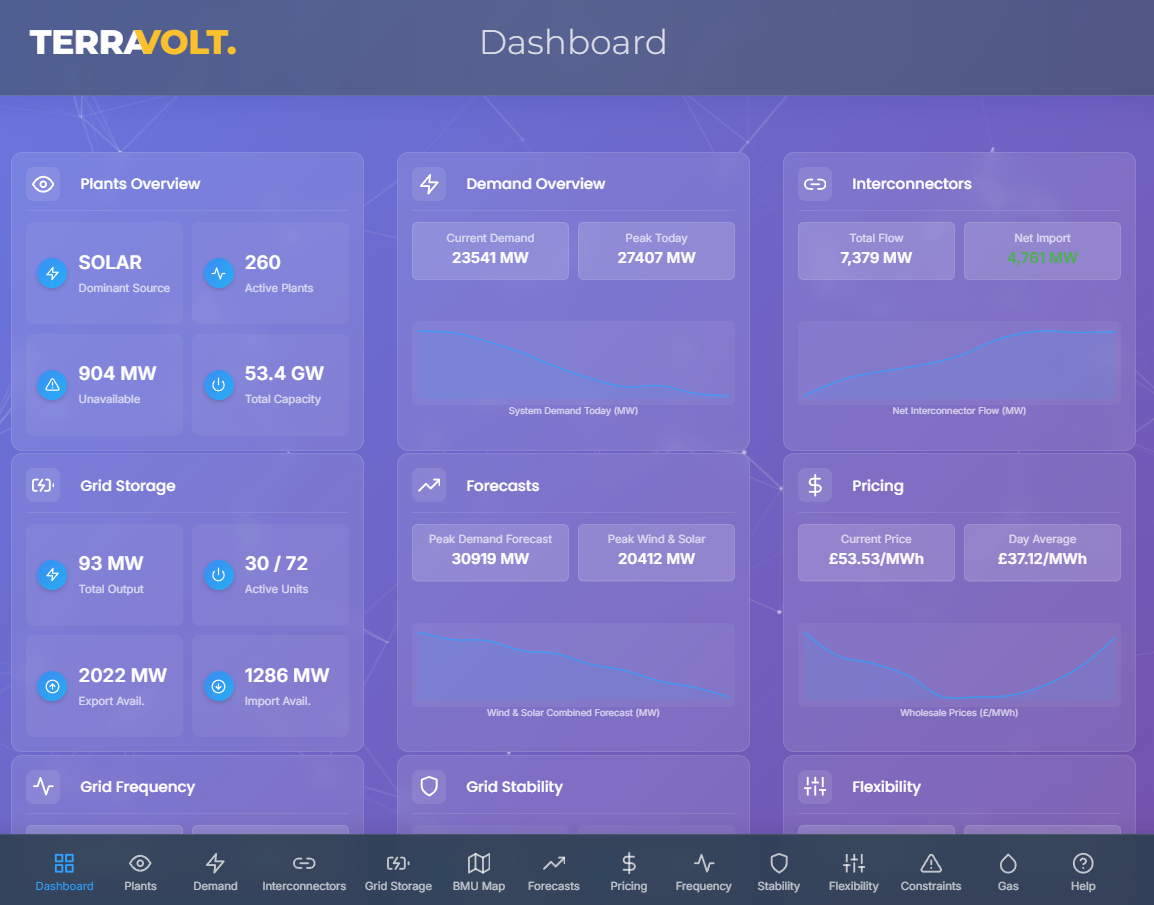This page is not recommended for use on mobile:
Switch?
Plant Status:
See “Notes” for how data is selected. Also read through “Known Issues”
Select Fuel type to show detail. (Chart will rescale once fuel type is selected to show data more clearly)
* Denotes Data Courtesy of RWE
† Denotes Data Supported by NGED Open Data
‡ Denotes Data Courtesy of UK Power Networks
UK Grid Fuel Mix Live & 24Hr:
Renewable Output Forecasts:
Wind Output Forecast Day Ahead (MW)
Solar Output Forecast Days Ahead (MW)
Greener Days Forecast:
The higher the score, the more wind generation predicted and the greener the day
Data courtesy of Octopus Energy
Live Gas Flow to Power Plants:
measured in mcm/day (million cubic meters per day)
Live Gas Export Flow:
measured in mcm/day (million cubic meters per day)
UK Grid Transfers:
Grid Stability Services:
*Note – STOR Auctions run 04:00 to 04:00 the following day, SFFR is the average availability over all the days time periods.
Interconnectors:
Regional Demand:
UK Power Demand by region: Helps identify how much power is being used in each area of the UK.
Now Moved to it’s own page here:
Notes
Where Maximum Export Limits are provided (MEL) alongside Physical Notification (FPN) & Bid Offer Acceptance Levels (BOAL) then these are shown as follows:
BOAL figures overrule both MEL & FPN. This figure is always used if it is available.
FPN > MEL = The MEL Figure is used
MEL > FPN = The FPN Figure is used
What does this mean?
MEL – Maximum Export Limit: It is the maximum power export level of a particular Unit at a particular time. A Units Maximum Export may be lower than its official rated output due to such things as maintenance, grid connection limitations, plant run up rates, low wind etc… It is therefore important to base output on the MEL figure should it be lower than the FPN figure for better output accuracy.
FPN – (Final) Physical Notification: A Physical Notification is the best estimate of the level of generation or demand that a plant operator expects a Unit to export or import in the ½ hour period.
BOAL/BOALF – Bid-Offer Acceptance Level: is a formalised representation of the purchase and/or sale of Offers and/or Bids by the System Operator in its operation of the Balancing Mechanism. It essentially shows as a deviation (increase or decrease) of a plants output from an FPN figure to balance demand against generation. The Grid being so fluid it may at times be necessary to ramp a plant’s output up or down to “balance” the grid several times in a ½ hour period.
2 Points should be noted with this:
1: BOALs are nowhere near as common occurrence as FPNs so most of the time the FPN is likely used.
2: BOALs are however common during times of grid stress and as such the output figure can change repeatedly in the same ½ hour period. This website picks the first BOAL figure it finds (if applicable) for each plant. This may show as some considerable drift of output against other Grid Monitoring sites by the end of the ½ hour period. It is however the most accurate plant output figure I have available at a given time which is why it overrides both MEL & FPN.
Scotland & England Transfer Boundary Info:
Interconnector & Region Information
Interconnectors: they are metered at the points listed below:
| Interconnector | Identifier | Metering Point | Bidding Zone |
|---|---|---|---|
| France (IFA) | INTFR | Sellindge | France |
| Northern Ireland (Moyle) | INTIRL | Auchencrosch | Ireland |
| Netherlands (BritNed) | INTNED | Grain | Netherlands |
| Ireland (East-West) | INTEW | Deeside | Ireland |
| Belgium (Nemolink) | INTNEM | Richborough | Belgium |
| France (ElecLink) | INTELEC | Sellindge | France |
| France (IFA2) | INTIFA2 | Chilling | France |
| Norway 2 (North Sea Link) | INTNSL | Blyth | Norway 2 |
Regions: for Virtual Power Plants (VPP) they are metered as to their zone region as below:
| Region | Region Name |
|---|---|
| A | Eastern England |
| B | East Midlands |
| C | London |
| D | Merseyside and Northern Wales |
| E | West Midlands |
| F | North Eastern England |
| G | North Western England |
| H | Southern England |
| J | South Eastern England |
| K | Southern Wales |
| L | South Western England |
| M | Yorkshire |
| N | Southern Scotland |
| P | Northern Scotland |
TP XX (Time Periods: Table)
If you are wondering what TP (Number) stands for in the center of the graph it shows which time period the data is from (as below.) The data refreshes every half hour and increments by 1. If the number does not increment over several hours something is wrong with the data stream and/or my database (sorry!)

Known Issues:
1: API data lag from BMRS: “API latest physical data (Near Real Time) is for current 1/2-hour settlement period + 2” -basically everything you see here is an hour out of date. If you are comparing this to other “Grid Monitor” sites
and it doesn’t add up this is normally why. (I’m working on a way around this to get nearer to realtime)
2: FPN vs MEL vs BOAL Figures: Currently all output figures above are “Physical Notifications” (FPN) from the plant. These are usually accurate HOWEVER there are occasions (such as when gradually raising load on a nuclear plant
or uncertainty on wind from an offshore windfarm) that a Plant Specific “Maximum Export Limit (MEL)” may be set
lower than the FPN. As such, the true output in this case is more likely to be nearer the lower MEL figure.
Ultimately, I need to figure a way of choosing the lower of the two values from the data (if FPN > MEL then Plant Output = MEL…) but this is again work in progress. Done 16/09/21
4: Solar – As far as I can find, no solar farms appear in BMRS data. If you know of any please let me know.
5: Interconnectors are a different data stream. I have it, just not implemented yet. Done 11/8/2021
6: All of this is Beta so don’t take it a 100% accurate or use it for anything critical. I’ve not spent any time tracking this data over time to make sure it’s all perfect yet. (And I’ve a lot of plant turbine/genset info to trawl
through.)
Data Courtesy of Elexon & bmreports
Supported by National Grid ESO Open Data & Estimated PV Output from Sheffield Solar


